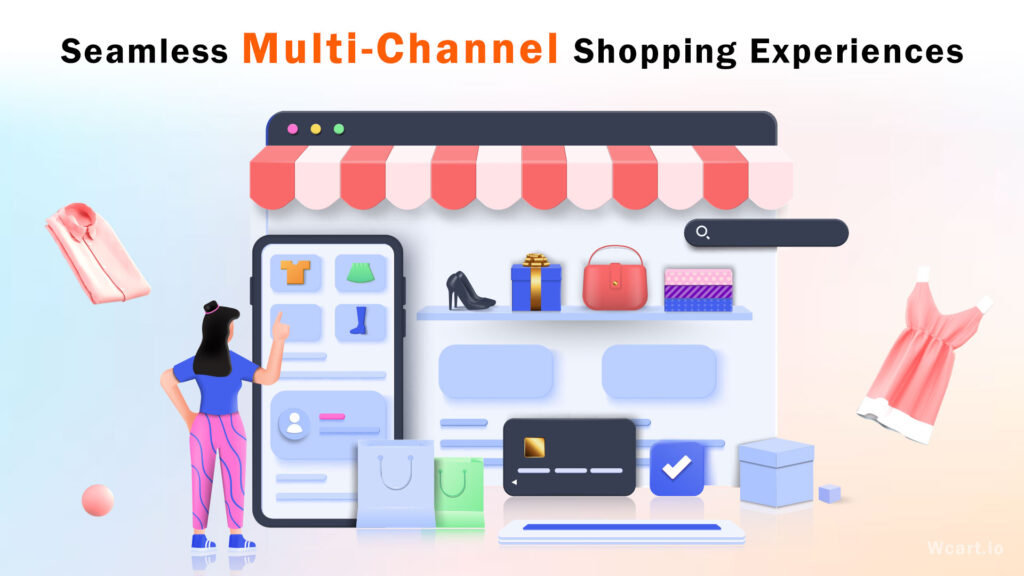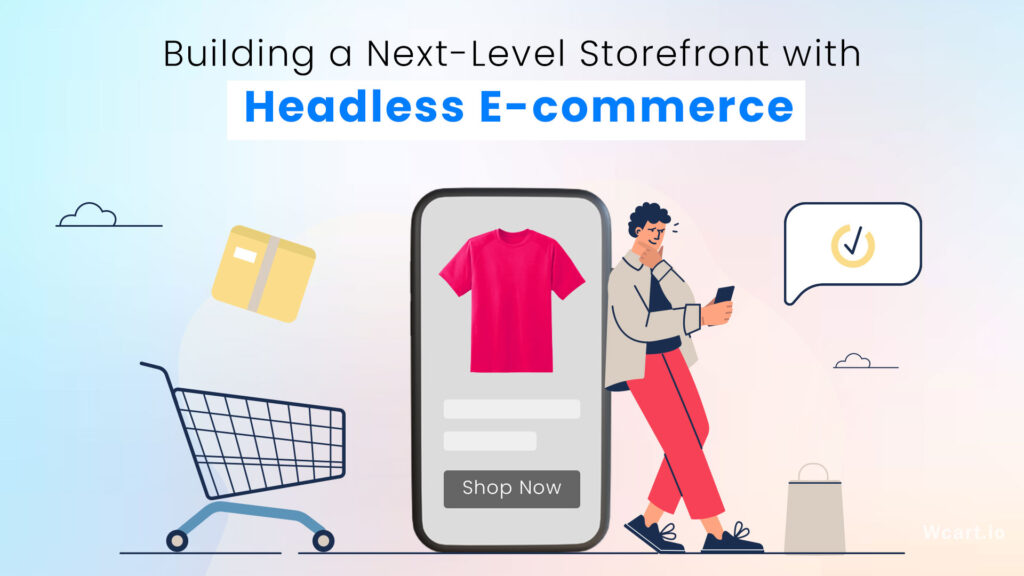The world of online retail is constantly evolving, and consumers now expect more than ever before from their shopping experiences. To meet these expectations, businesses need to embrace innovative solutions that can provide a next-level shopping experience. One such solution that is revolutionizing the e-commerce landscape is the advent of headless e-commerce platforms. These platforms offer a new approach to online retail by decoupling the front-end and back-end, allowing for greater flexibility, scalability, and personalization. In this article, we will explore the concept of headless e-commerce platforms, their advantages, and how they are reshaping the way businesses engage with their customers. Get ready to discover how headless e-commerce platforms are paving the way for a new era of online retail.
Introducing Headless E-commerce Platforms
Headless e-commerce platforms are a new type of technology that is transforming the way online retail works. Unlike traditional e-commerce platforms, headless platforms separate the front-end and back-end of an online store.
In simple terms, the front-end is the part of the website that customers see and interact with, such as the design, layout, and user interface. The back-end, on the other hand, handles the behind-the-scenes operations like inventory management, processing orders, and data storage.
With headless e-commerce platforms, businesses have the freedom to choose different technologies for the front-end and back-end. This means they can use the latest and most suitable tools for each part, resulting in a more flexible and customizable online shopping experience.
By decoupling the front-end and back-end, headless platforms enable businesses to create unique and engaging storefronts that can adapt to different devices and customer preferences. They also provide the opportunity to integrate emerging technologies like voice-activated
shopping assistants and Internet of Things (IoT) devices for a more connected shopping experience.
Overall, headless e-commerce platforms empower businesses to create next-level online stores that are more personalized, scalable, and capable of delivering exceptional shopping experiences to customers.
Understanding Headless E-commerce Platforms
Headless e-commerce platforms are a new type of technology that is revolutionizing the world of online retail. To understand headless e-commerce platforms, it’s important to grasp the concept of decoupling the front-end and back-end of an online store.
- Front-end refers to the part of the website that customers see and interact with, such as the design, layout, and user interface.
- Back-end, on the other hand, handles the behind-the-scenes operations like inventory management, processing orders, and data storage.
Headless e-commerce platforms differ from traditional e-commerce platforms by separating these two components. This separation allows businesses to have more flexibility and freedom in choosing different technologies for the front-end and back-end.
With a headless e-commerce platform, businesses can select the best tools and technologies for each part, rather than being tied to a single integrated solution. This flexibility enables businesses to create unique and customized storefronts that provide a superior shopping experience for customers.
Additionally, headless e-commerce platforms offer advantages such as improved performance and scalability. So, by decoupling the front-end and back-end, these platforms can deliver faster page load times and handle high volumes of traffic more effectively.
Overall, understanding headless e-commerce platforms means recognizing the power of separating the front-end and back-end of an online store. It opens up opportunities for businesses to create highly personalized and scalable shopping experiences that meet the evolving needs and expectations of customers in the digital era.
Advantages of headless e-commerce platforms

Headless e-commerce platforms offer several advantages that make them an attractive choice for businesses looking to enhance their online retail operations. Here are some of the key advantages of headless e-commerce platforms:
- Improved Performance: By decoupling the front-end and back-end, headless e-commerce platforms can optimize performance. This separation allows for faster page load times, resulting in a smoother and more responsive shopping experience for customers. Improved performance can lead to higher customer satisfaction and increased conversion rates.
- Scalability: Headless e-commerce platforms are designed to handle high volumes of traffic and accommodate growth. The separation of the front-end and back-end allows businesses to scale each component independently, ensuring that the online store remains performant and responsive even during peak periods of activity.
- Omnichannel Capabilities: Headless e-commerce platforms empower businesses to deliver consistent shopping experiences across multiple channels and devices. With a decoupled architecture, businesses can easily adapt their front-end to different screen sizes, devices, and platforms, providing a seamless experience for customers whether they are shopping on a desktop, mobile device, or even through voice-activated assistants.
- Integration Capabilities: Headless e-commerce platforms offer robust integration capabilities with other systems and technologies. Businesses can seamlessly connect their online store with various backend systems, such as customer relationship management (CRM), inventory management, and enterprise resource planning (ERP), streamlining operations and enhancing overall efficiency.
- Future-Proofing: Headless e-commerce platforms provide a future-proof solution for businesses. As technology advances and new devices or channels emerge, businesses can easily adapt and integrate them into their existing architecture.
In summary, the advantages of headless e-commerce platforms lie in their flexibility, performance, scalability, omnichannel capabilities, integration capabilities, and future-proofing capabilities. These advantages enable businesses to create unique, personalized, and seamless shopping experiences that drive customer satisfaction, loyalty, and business growth.
Unleashing the Power of Headless E-commerce
Headless e-commerce platforms have the potential to transform the way businesses engage with their customers and redefine online retail. By leveraging the power of headless architecture, businesses can unlock a multitude of benefits and capabilities that take their online shopping experiences to the next level.
Seamless Multi-Channel Shopping Experiences:

- Personalized Shopping Across Devices: Headless e-commerce platforms enable businesses to deliver consistent and personalized shopping experiences across different devices, such as smartphones, tablets, and desktops. Customers can seamlessly browse and make purchases, regardless of the device they are using.
- Integrating IoT Devices for Connected Shopping: With headless platforms, businesses can leverage Internet of Things (IoT) devices to create innovative and connected shopping experiences. For example, customers can interact with smart home devices to add products to their shopping cart or use wearable devices for personalized product recommendations.
- Voice-Activated Shopping Assistants: Headless e-commerce platforms allow integration with voice-activated shopping assistants like Amazon Alexa or Google Assistant. Customers can use voice commands to search for products, add items to their cart, and complete purchases, providing a convenient and hands-free shopping experience.
Enhanced Performance and Scalability:

- Faster Page Load Times: Headless e-commerce platforms excel in delivering faster page load times, reducing latency, and improving overall performance. This ensures that customers can navigate through the online store swiftly, leading to higher engagement and increased conversions.
- Handling High Traffic Volumes: By utilizing a server less architecture and optimized APIs, headless platforms can handle high volumes of website traffic effectively. Businesses can scale their online stores seamlessly during peak periods, such as sales events or promotional campaigns, without compromising performance.
- Serverless Architecture for Improved Scalability: Headless platforms leverage serverless infrastructure, eliminating the need for managing and provisioning servers. This architecture allows businesses to scale resources dynamically, ensuring a seamless shopping experience even during sudden spikes in traffic.
Advanced Personalization Techniques:

- Tailoring Product Recommendations: Headless e-commerce platforms enable businesses to leverage customer data and advanced algorithms to deliver highly personalized product recommendations. By analyzing customer behavior, preferences, and purchase history, businesses can suggest relevant products, increasing the likelihood of conversions and customer satisfaction.
- Dynamic Pricing Based on User Behavior: With headless platforms, businesses can implement dynamic pricing strategies that adjust prices based on individual customer behavior, demand, and market conditions. This personalized pricing approach enhances customer loyalty and provides a competitive edge in the market.
- Contextual Content Delivery: Headless e-commerce platforms allow businesses to deliver contextual content based on customer interactions and preferences. By presenting targeted content, such as personalized promotions or relevant blog articles, businesses can engage customers and drive conversions.
Unleashing the power of headless e-commerce platforms empowers businesses to create seamless multi-channel shopping experiences, achieve enhanced performance and scalability, and leverage advanced personalization techniques. Hence, harnessing these capabilities, businesses can elevate their online retail presence, deliver exceptional shopping experiences, and stay ahead in the ever-evolving digital landscape.
Building a Next-Level Storefront with Headless E-commerce

Creating a captivating storefront is essential to providing a next-level shopping experience for customers. With headless e-commerce platforms, businesses have the opportunity to design and build a storefront that goes beyond the traditional online retail experience. Here’s how to build a next-level storefront using headless e-commerce:
Designing a Captivating Front-End Experience:
Customizable User Interfaces: Headless e-commerce platforms allow businesses to design unique and visually appealing user interfaces that reflect their brand identity. Customization options include layout, color schemes, typography, and interactive elements, creating a visually captivating storefront.
Innovative User Interactions and Animations: Incorporating innovative user interactions, such as product previews, interactive product galleries, or dynamic loading effects, enhances the user experience and engages customers. Thoughtfully designed animations and transitions can provide a delightful and memorable shopping experience.
Adaptive Layouts for Different Devices: With headless platforms, businesses can create responsive and adaptive storefronts that automatically adjust to different screen sizes and devices. This ensures a consistent and optimized shopping experience, whether customers are browsing on a desktop, tablet, or smartphone.
Read More: To Know about Dos and Don’ts in Ecommerce Web Design
Leveraging Advanced Personalization Techniques:
Tailoring Product Recommendations: Headless e-commerce platforms enable businesses to implement sophisticated algorithms that analyze customer behavior, preferences, and purchase history to deliver highly personalized product recommendations. This level of personalization enhances customer engagement and increases the likelihood of conversions.
Dynamic Pricing and Discounts: Implementing dynamic pricing based on customer segments, loyalty levels, or real-time market conditions can create a sense of exclusivity and urgency. Offering personalized discounts and promotions tailored to individual customers can significantly boost conversion rates.
Contextual Content Delivery: Headless e-commerce platforms allow businesses to deliver relevant and contextual content to customers based on their browsing behavior or purchase history. This can include personalized blog recommendations, how-to guides, or user-generated content, providing valuable information and enhancing the overall shopping experience.
Seamless Integration with Third-Party Services:
Payment Gateways: Integrating with popular payment gateways ensures a seamless and secure checkout process. Supporting various payment methods and offering a frictionless payment experience enhances customer satisfaction and trust.
Shipping and Fulfillment: Integrating with shipping carriers and fulfillment services streamlines the order fulfillment process, providing real-time shipping rates, tracking information, and automated order processing. This improves efficiency and customer satisfaction.
CRM and Marketing Automation: Integrating headless e-commerce platforms with customer relationship management (CRM) systems and marketing automation tools enables businesses to capture and utilize customer data effectively. This integration facilitates personalized marketing campaigns, loyalty programs, and targeted communication with customers.
Read More: To Know about Features to Look for Ecommerce Builder
Overall, businesses can build a next-level storefront by leveraging advanced personalization techniques, seamlessly integrating with third-party services, and focusing on designing a captivating front-end experience using headless e-commerce platforms. So, this approach allows businesses to create a unique and immersive shopping experience that sets them apart from the competition and delights customers throughout their journey.
Overcoming Challenges and Considerations

While headless e-commerce platforms offer numerous advantages, businesses should be aware of the challenges and considerations that come with adopting this innovative approach. So,by addressing these challenges, businesses can effectively overcome them and maximize the benefits of headless e-commerce.
Front-End Development Expertise:
- Challenge: Headless e-commerce requires expertise in front-end development as businesses need to build custom front-end interfaces.
- Solution: Investing in skilled front-end developers or partnering with agencies specializing in headless e-commerce can ensure the successful implementation and ongoing development of the storefront.
Read More: To Know about Ecommerce Developers Skills
Increased Development Complexity:
- Challenge: Decoupling the front-end and back-end introduces increased development complexity, as two separate systems need to be managed and integrated.
- Solution: Employing agile development methodologies, leveraging API-driven architectures, and adopting effective collaboration tools can streamline development processes and facilitate seamless integration between the front-end and back-end.
API Management and Maintenance:
- Challenge: Headless e-commerce relies heavily on APIs to connect the front-end and back-end systems, necessitating proper API management and maintenance.
- Solution: Implementing robust API management practices, including versioning, documentation, and monitoring, helps ensure the reliability, security, and scalability of the APIs. Regular maintenance and updates of the API infrastructure are essential to address potential issues and stay up-to-date with technology advancements.
Content Management and SEO:
- Challenge: Content management and search engine optimization (SEO) become more complex in headless e-commerce as content needs to be managed separately from the storefront.
- Solution: Employing a headless content management system (CMS) that integrates with the headless e-commerce platform facilitates efficient content management and SEO optimization. Ensuring proper metadata, structured data, and URL management is crucial for maintaining search engine visibility.
Performance Monitoring and Optimization:
- Challenge: With the decoupling of the front-end and back-end, monitoring and optimizing the performance of the entire system can be challenging.
- Solution: Implementing performance monitoring tools and techniques to track key metrics such as page load times, server response times, and user interactions helps identify performance bottlenecks. Regular performance audits and optimizations ensure a smooth and fast shopping experience.
Vendor Selection:
- Challenge: Selecting the right headless e-commerce platform vendor is crucial for success, as it impacts the scalability, support, and future-proofing of the solution.
- Solution: Thoroughly evaluating vendors based on their features, scalability, integration capabilities, support services, and long-term roadmap helps ensure the selection of a reliable and future-proof platform that aligns with business goals.
Data Security and Compliance:
- Challenge: As headless e-commerce involves multiple systems and data transfers, ensuring data security and compliance with regulations becomes critical.
- Solution: Implementing robust security measures, including data encryption, secure APIs, access controls, and compliance with relevant regulations such as GDPR or CCPA, safeguards customer data and builds trust.
Overall by proactively addressing these challenges and considerations, businesses can overcome potential hurdles and maximize the advantages of headless e-commerce, enabling them to create innovative and seamless shopping experiences for their customers.
Conclusion
In conclusion, headless e-commerce platforms offer businesses the opportunity to redefine online retail and create next-level shopping experiences. By decoupling the front-end and back-end, businesses gain flexibility, customization options, and the ability to deliver personalized and engaging storefronts. Despite the challenges of front-end development expertise, increased complexity, API management, content management, performance monitoring, vendor selection, and data security, these obstacles can be overcome with careful planning and implementation.
By embracing the power of headless e-commerce and addressing these considerations, businesses can unlock the potential to captivate customers, drive conversions, and stay ahead in the ever-evolving digital landscape. Finally with the right strategy and execution, businesses can build a successful next-level storefront that stands out in the competitive online retail industry.
Frequently Asked Questions(FAQs)
What is a headless e-commerce platform?
A headless e-commerce platform is a type of software architecture that decouples the front-end presentation layer (the “head”) from the back-end e-commerce functionality. In a headless setup, the front-end can be built using any technology stack, while the e-commerce functionality and data are accessed via APIs.
What are the benefits of using a headless e-commerce platform?
Using a headless e-commerce platform offers several advantages.
First, it provides greater flexibility and freedom in designing and delivering unique user experiences across multiple channels.
Second, it enables faster development and deployment of front-end interfaces without impacting the underlying e-commerce functionality.
Finally, it allows for seamless integration with various third-party services and technologies.
How does a headless e-commerce platform work?
In a headless e-commerce platform, the back-end system handles core e-commerce processes such as inventory management, order processing, and payment processing. The front-end presentation layer, which can be built using different technologies like React, Angular, or mobile apps, consumes data through APIs provided by the back-end. This decoupling of the front-end and back-end enables independent updates and scalability.
Can I still manage content and product information with a headless e-commerce platform?
Yes, with a headless e-commerce platform, you can still manage content and product information. Many headless platforms provide a (CMS) or (PIM) system that allows you to create and organize content and products. These systems usually offer APIs to retrieve and update the content or product data from the back-end.
Is a headless e-commerce platform suitable for my business?
A headless e-commerce platform is a good fit for businesses that require flexibility, scalability, and the ability to deliver consistent experiences across various channels. It is particularly beneficial for companies with complex requirements, such as those operating in multiple regions or selling through different touchpoints.




Leave a Reply